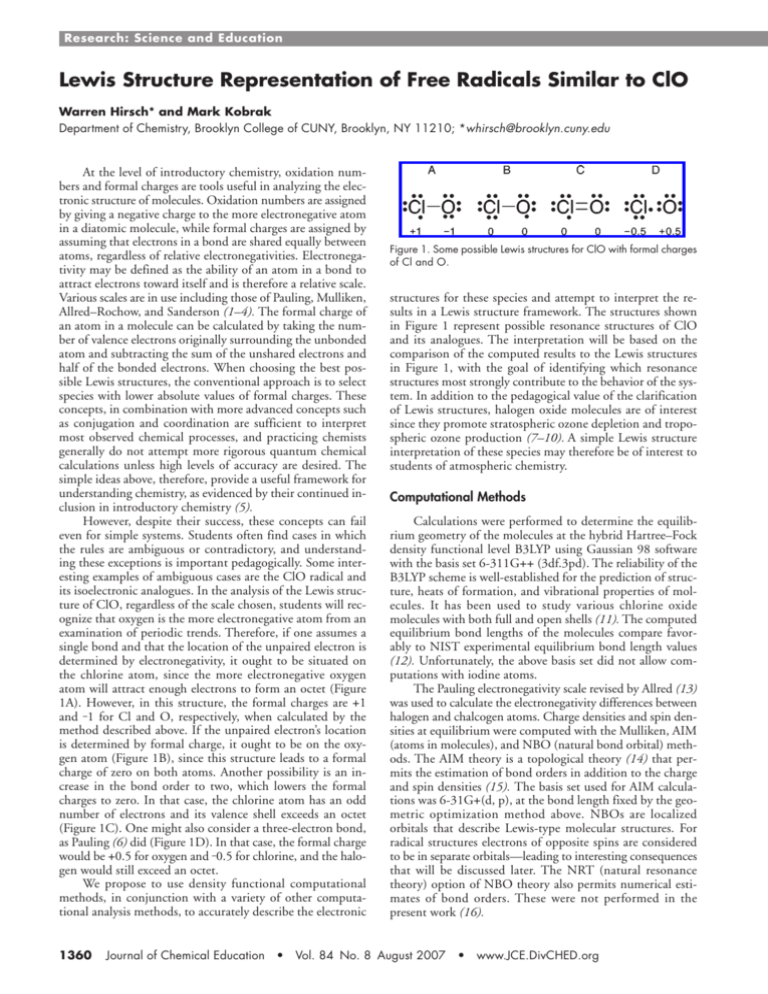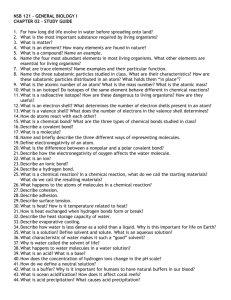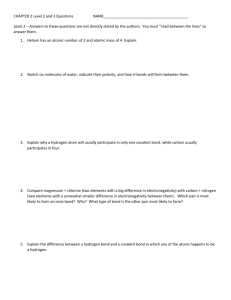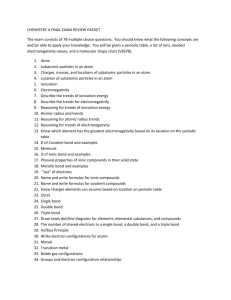
Research: Science and Education
Lewis Structure Representation of Free Radicals Similar to ClO
Warren Hirsch* and Mark Kobrak
Department of Chemistry, Brooklyn College of CUNY, Brooklyn, NY 11210; *whirsch@brooklyn.cuny.edu
At the level of introductory chemistry, oxidation numbers and formal charges are tools useful in analyzing the electronic structure of molecules. Oxidation numbers are assigned
by giving a negative charge to the more electronegative atom
in a diatomic molecule, while formal charges are assigned by
assuming that electrons in a bond are shared equally between
atoms, regardless of relative electronegativities. Electronegativity may be defined as the ability of an atom in a bond to
attract electrons toward itself and is therefore a relative scale.
Various scales are in use including those of Pauling, Mulliken,
Allred–Rochow, and Sanderson (1–4). The formal charge of
an atom in a molecule can be calculated by taking the number of valence electrons originally surrounding the unbonded
atom and subtracting the sum of the unshared electrons and
half of the bonded electrons. When choosing the best possible Lewis structures, the conventional approach is to select
species with lower absolute values of formal charges. These
concepts, in combination with more advanced concepts such
as conjugation and coordination are sufficient to interpret
most observed chemical processes, and practicing chemists
generally do not attempt more rigorous quantum chemical
calculations unless high levels of accuracy are desired. The
simple ideas above, therefore, provide a useful framework for
understanding chemistry, as evidenced by their continued inclusion in introductory chemistry (5).
However, despite their success, these concepts can fail
even for simple systems. Students often find cases in which
the rules are ambiguous or contradictory, and understanding these exceptions is important pedagogically. Some interesting examples of ambiguous cases are the ClO radical and
its isoelectronic analogues. In the analysis of the Lewis structure of ClO, regardless of the scale chosen, students will recognize that oxygen is the more electronegative atom from an
examination of periodic trends. Therefore, if one assumes a
single bond and that the location of the unpaired electron is
determined by electronegativity, it ought to be situated on
the chlorine atom, since the more electronegative oxygen
atom will attract enough electrons to form an octet (Figure
1A). However, in this structure, the formal charges are +1
and ᎑1 for Cl and O, respectively, when calculated by the
method described above. If the unpaired electron’s location
is determined by formal charge, it ought to be on the oxygen atom (Figure 1B), since this structure leads to a formal
charge of zero on both atoms. Another possibility is an increase in the bond order to two, which lowers the formal
charges to zero. In that case, the chlorine atom has an odd
number of electrons and its valence shell exceeds an octet
(Figure 1C). One might also consider a three-electron bond,
as Pauling (6) did (Figure 1D). In that case, the formal charge
would be +0.5 for oxygen and ᎑0.5 for chlorine, and the halogen would still exceed an octet.
We propose to use density functional computational
methods, in conjunction with a variety of other computational analysis methods, to accurately describe the electronic
1360
Journal of Chemical Education
•
Figure 1. Some possible Lewis structures for ClO with formal charges
of Cl and O.
structures for these species and attempt to interpret the results in a Lewis structure framework. The structures shown
in Figure 1 represent possible resonance structures of ClO
and its analogues. The interpretation will be based on the
comparison of the computed results to the Lewis structures
in Figure 1, with the goal of identifying which resonance
structures most strongly contribute to the behavior of the system. In addition to the pedagogical value of the clarification
of Lewis structures, halogen oxide molecules are of interest
since they promote stratospheric ozone depletion and tropospheric ozone production (7–10). A simple Lewis structure
interpretation of these species may therefore be of interest to
students of atmospheric chemistry.
Computational Methods
Calculations were performed to determine the equilibrium geometry of the molecules at the hybrid Hartree–Fock
density functional level B3LYP using Gaussian 98 software
with the basis set 6-311G++ (3df.3pd). The reliability of the
B3LYP scheme is well-established for the prediction of structure, heats of formation, and vibrational properties of molecules. It has been used to study various chlorine oxide
molecules with both full and open shells (11). The computed
equilibrium bond lengths of the molecules compare favorably to NIST experimental equilibrium bond length values
(12). Unfortunately, the above basis set did not allow computations with iodine atoms.
The Pauling electronegativity scale revised by Allred (13)
was used to calculate the electronegativity differences between
halogen and chalcogen atoms. Charge densities and spin densities at equilibrium were computed with the Mulliken, AIM
(atoms in molecules), and NBO (natural bond orbital) methods. The AIM theory is a topological theory (14) that permits the estimation of bond orders in addition to the charge
and spin densities (15). The basis set used for AIM calculations was 6-31G+(d, p), at the bond length fixed by the geometric optimization method above. NBOs are localized
orbitals that describe Lewis-type molecular structures. For
radical structures electrons of opposite spins are considered
to be in separate orbitals—leading to interesting consequences
that will be discussed later. The NRT (natural resonance
theory) option of NBO theory also permits numerical estimates of bond orders. These were not performed in the
present work (16).
Vol. 84 No. 8 August 2007
•
www.JCE.DivCHED.org
Research: Science and Education
The correlation coefficients between the electronegativity differences, ∆χ, and both the charge and spin densities
computed by the three methods were determined, allowing
for a comparison of the reliability of results given by these
methods. The results of the calculations are listed in Table 1.
Results and Discussion
The halogen spin densities calculated by the three methods show significant correlation with the electronegativity
differences. In Figure 2, we plot the Mulliken spin density
on the halogen atom versus the Pauling electronegativity difference between the group 16 (chalcogen) atom and the group
17 (halogen) atom (∆χ = χ16 − χ17) for the nine isoelectronic
compounds. It is evident that the spin density on the halogen atom increases as the electronegativity difference increases. The atomic charges of the halogen calculated by both
the AIM and NBO methods also correlated strongly with the
electronegativity difference, though the correlation in the
Mulliken charges was considerably weaker. In the case of SBr,
only AIM theory gives a negative charge for bromine, consistent with the fact that bromine is more electronegative than
sulfur.
One should note that for all of the calculations, regardless of the sign or magnitude of the electronegativity difference, the chalcogen atom had a greater spin density than that
of the halogen atom. Based on analysis of the Lewis structures in Figure 1, this indicates that formal charge is a more
important factor than electronegativity in the configuration
of the odd electron. According to the Mulliken calculations
for ClO, approximately 70% of the spin density resides on
the oxygen atom, making structure B the best structure of
those in Figure 1. The linear correlation coefficient for the
nine points on the plot is r = 0.949, indicating a confidence
level of better than 99.9% certainty in the hypothesis that
increasing electronegativity difference augments the halogen
spin density. In fact, for SeF, which had the most negative
electronegativity difference of all the molecules studied
(᎑1.43), about 94% of the spin density resides on the Se atom
and only about 6% on the F atom.
Figure 2. Effect of Pauling electronegativity difference on Mulliken
spin density of halogen.
For OF, about 87% of the spin density is on the oxygen
atom, indicating that structure B is the most strongly contributing resonance form. However, structure B does not adequately depict the bond order. The AIM bond order for OF
was computed to be 1.5, consistent with simple molecular
orbital theory, taking one half the difference between the
number of electrons occupying bonding and antibonding
MOs:
σ(2s)2 σ*(2s)2 σ(2px)2 σ*(2px)2 π(2py)2 π(2pz) 2 π*(2py)1
This MO method is included in most general chemistry textbooks (17). Ordinary Lewis structures are inadequate to describe this molecule since, in the case of OF, hypervalency is
not possible on either atom because of the absence of lowlying d orbitals. Structures similar to C or D in Figure 1 are
therefore prohibited. In fact, analysis using NBO theory
shows that in the case of ClO, where hypervalency in the
case of the chlorine atom is possible, there is very little contribution from d orbitals. This was true for all of the molecules studied.
Table 1. Properties of Halogen Monoxides and Analogs
Halogen
Equilibrium
Bond Length
Calc/Å
Equilibrium
Bond Length
NIST/Å
Pauling
∆χ
SeF
1.76
–––
SF
1.62
SeCl
Mulliken
Spin
Density
Mulliken
Charge
AIM
Spin
Density
᎑1.43
0.053
᎑0.355
1.60
᎑1.40
0.067
2.14
–––
᎑0.61
SCl
1.99
1.98
OF
1.35
SeBr
AIM
Bond
Order
AIM
Charge
NBO
Spin
Density
NBO
Charge
0.089
᎑0.594
0.064
᎑0.510
1.1
᎑0.175
0.114
᎑0.597
0.083
᎑0.458
1.2
0.112
᎑0.254
0.134
᎑0.252
0.119
᎑0.187
1.4
᎑0.58
0.148
᎑0.110
0.168
᎑0.156
0.150
᎑0.087
1.5
1.35
᎑0.54
0.128
᎑0.056
0.149
᎑0.110
0.133
᎑0.081
1.5
2.29
–––
᎑0.41
0.128
᎑0.069
0.158
᎑0.150
0.137
᎑0.081
1.5
SBr
2.15
–––
᎑0.38
0.175
᎑0.045
0.193
᎑0.033
0.168
᎑0.018
1.6
ClO
1.58
1.58
᎑0.28
0.301
᎑0.183
0.283
᎑0.445
0.292
᎑0.433
1.7
BrO
1.73
1.73
᎑0.48
0.286
᎑0.553
0.298
᎑0.524
0.286
᎑0.495
1.7
0.949
0.881
0.945
0.987
0.948
0.987
0.96
Molecule
Correlation Coefficient with ∆χ
NOTE: The sum of the spin densities of both atoms in the molecule equals one and that the sum of the atomic charges equals zero. ∆χ = χ1 6 − χ1 7 .
www.JCE.DivCHED.org
•
Vol. 84 No. 8 August 2007
•
Journal of Chemical Education
1361
Research: Science and Education
Figure 3. A novel Lewis representation of ClO.
NBO theory considers electrons of opposite spins to be
in separate, singly occupied orbitals. The nonbonding electrons are localized on the atoms, while the bonding orbitals
are two-center. This leads to two separate Lewis structures,
corresponding to the two spin directions. Since the number
of electrons is odd, the number of electrons is different for
each structure. The α structure has the majority of the electrons and the β structure has the minority. For ClO (in fact
for all of the nine compounds except SF and SeF) the α structure has one singly occupied σ bond and six singly occupied
nonbonding orbitals—three on each atom. The β structure
has a σ bond and a π bond and two nonbonding orbitals on
each atom. The NBO treatment not only embraces the “different orbitals for different spins” concept, but also the “different hybrids for different spins” concept (18). Using the
latter concept, the α structure with a single bond and six nonbonding sites may be considered to be akin to the ClO− anion. The β structure with two bonds and four nonbonding
sites may be considered akin to the singlet ClO+ cation. This
treatment is at variance with that of valence bond theory,
where resonance structures are different forms of the same
molecule. The bond lengths for the species ClO−, ClO, and
ClO+ were calculated to be 1.69 Å, 1.58 Å, and 1.47 Å, respectively, indicating that the bond order of the ClO radical
is between that of the singly bonded anion and the doubly
bonded cation. The AIM bond orders for these species were
calculated to be 1.4, 1.8, and 2.1, respectively, giving further support to this idea, although the numerical values
should be considered to be relative, rather than exact. The
superposition of α and β structures leads to average formal
charges of +0.5 and ᎑0.5 of the chlorine and oxygen atoms,
respectively.
Interestingly, if structures B and C (both having zero formal charges on each atom) are combined, one may represent
the results as the hybrid structure shown in Figure 3, which
has a three-electron bond and an odd electron on each atom.
This is essentially the result obtained from NBO theory. This
structure violates the usual rules for drawing Lewis structures,
which requires electrons to be paired, if possible. However,
each atom has an octet, so that hypervalency, involving d electrons, need not be invoked. The total spin of the molecule is
also equivalent to one unpaired electron owing to cancellation of opposite spins.
It remains to account for the greater spin density on the
chalcogen atom and also the trend in the spin density of the
halogen atom versus the electronegativity difference. The unpaired electron in the three-electron bond, which is in a pi
orbital, will be more strongly attracted to the halogen with a
charge of +0.5 than to the oxygen with a charge of ᎑0.5. Since
1362
Journal of Chemical Education
•
it has a β spin, it will partially cancel the α spin of the unpaired electron on the halogen, therefore leaving the chalcogen with the greater spin density. The greater the
electronegativity difference between the chalcogen and halogen atoms, the greater this effect will be. As the difference
between the chalcogen and halogen electronegativities increases, the β pi electron will become more polarized toward
the chalcogen, diminishing the spin cancellation on the halogen, and therefore increasing the halogen spin density. This
explains the trend observed in Figure 2.
According to NBO analysis, the molecules SF and SeF
each contain a single bond and an unpaired electron on the
chalcogen atom. Therefore, they are both well represented
by structure B in Figure 1. The AIM bond orders for SF and
SeF are 1.2 and 1.1, respectively, lending further credence to
the existence of a single bond. It is likely that p orbital overlap between the second row fluorine and the third and fourth
row sulfur and selenium atoms is poor, making pi bonding
difficult.
Conclusions
In the general chemistry classroom, if one has to present
a single simple Lewis structure for a radical formed from a
halogen atom and a chalcogen atom, the best structure is akin
to Figure 1B—that is, a single bonded molecule with the odd
electron on the chalcogen atom. For SF and SeF, the description is adequate. However, for the other seven molecules studied, the bond order is not represented accurately. Formal
charge and hypervalency considerations may be included in
the discussion of structures akin to Figures 1A, 1C, and 1D.
For innovative instruction, and a bright group of students,
the novel structure in Figure 3 is proposed. In the physical
chemistry or computational chemistry classroom, a discussion of how these conclusions are reached may prove to be
interesting. The effect of the electronegativity difference on
the halogen spin density may be included in the context of
NBO Theory.
Literature Cited
1. Pauling, L. The Nature of the Chemical Bond, 3rd ed.; Cornell
University: Ithaca, NY, 1960; pp 88–94.
2. (a) Mulliken, R. S. J. Chem. Phys. 1934, 2, 782. (b) Mulliken,
R. S. J. Chem. Phys. 1935, 3, 573.
3. Allred, A. L.; Rochow, E. G. J. Inorg. Nucl. Chem. 1958, 5,
264, 269.
4. Sanderson, R. T. J. Chem. Educ. 1988, 65, 112.
5. Brown, T.; Lemay, E.; Bursten B. Chemistry—The Central Science, 10th ed.; Pearson-Prentice Hall: Upper Saddle River, NJ,
2006; pp 309–325.
6. Pauling, L. The Nature of the Chemical Bond, 3rd ed.; Cornell
University: Ithaca, NY, 1960; pp 341–356.
7. Platt, U.; Janssen, C. Faraday Discuss. 1996, 100, 175–178.
8. Platt, U.; Honninger, G. Chemosphere 2003, 52, 325–338.
9. Buben, S. N.; Larin, I. K.; Trofimova, E. M.; Spasskii, A. I.; Messineva,
N. A.; Turkin, L. E. Khimicheskaya Fizika 2002, 21, 52–60.
10. Tuckermann, M.; Ackermann, R.; Goelz, C.; Lorenzen-
Vol. 84 No. 8 August 2007
•
www.JCE.DivCHED.org
Research: Science and Education
11.
12.
13.
14.
Schmidt, H.; Senne, T.; Stutz, J.; Trost, B.; Unold, W.;
Platt, U. Tellus, Series B: Chemical and Physical Meteorology
1997, 49B, 33–555.
Beltran, A.; Andres, J.; Noury, S.; Silvi, B. J. Phys. Chem. A
1999, 103, 3078–3088.
National Institute of Standards and Technology. Computational Chemistry Comparison and Benchmark DataBase.
http://srdata.nist.gov/cccbdb/ (accessed Apr 2007).
Allred, A. L. J. Inorg. Nucl. Chem. 1961, 17, 215.
(a) Bader, R. F. W. Atoms in Molecules—A Quantum Theory;
Oxford University Press: Oxford, 1990. (b) Bader, R. F. W.
Atoms and Molecules. http://www.chemistry.mcmaster.ca/faculty/
bader/aim (accessed Apr 2007).
www.JCE.DivCHED.org
•
15. Cioslowski, J.; Mixon, S. J. Am. Chem. Soc. 1991, 113, 4142–
4145.
16. (a) Glendening, E.; Morales, C.; Weinhold, F. What Are NBOs
(and Other "Natural"-Type Orbitals)? http://www.chem.
wisc.edu/~nbo5/web_nbo.htm (accessed Apr 2007). (b)
Weinhold, F.; Landis, C. R. Valency and Bonding—A Natural
Bond Orbital Donor-Acceptor Perspective; Cambridge University Press: Cambridge, 2005.
17. Brown, T.; Lemay, E.; Bursten B. Chemistry—The Central Science, 10th ed.; Pearson-Prentice Hall: Upper Saddle River, NJ,
2006; pp 380–381.
18. Carpenter, J. E.; Weinhold F. J. Molecular Structure (Theochem)
1988, 169, 41–62.
Vol. 84 No. 8 August 2007
•
Journal of Chemical Education
1363






